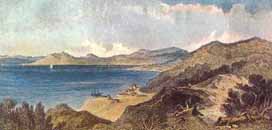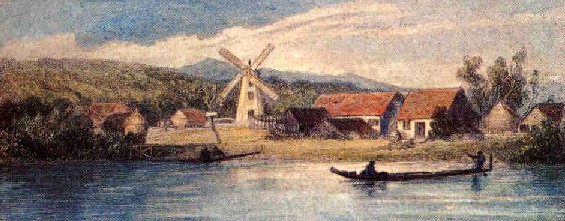 | Twelve months in Wellington / by John Wood (1843)
Chapter 15 |
| Contents: narrative | chapters: 1 | 2 | 3 | 4 | 5 | 6 | 7 | 8 | 9 | 10 | 11 | 12 | 13 | 14 | 15 | 16 | 17 | |
Anonymous writers assert that all the land in New Zealand is worthless, uncultivable, or inaccessible. Against this we have the testimony of travellers who have visited the country - of the Hon. Mr. Petre, whose word is above suspicion; of Mr. Bidwell, whom we know personally to be a good judge, and, what is no doubt important, a disinterested witness; and of the responsible officers of her Majesty's Government. It was only the other night that the Noble Lord, the Secretary for the Colonies, stated in the House of Commons that there exists an enormous quantity of fertile land in New Zealand. Upon turning to Mr. Bidwell's pamphlet, we find him speaking of the country everywhere towards the south of the northern island as admirably adapted for cultivation, with plains suited for rearing herds of cattle ; and describing Port Nicholson, the principal settlement of the New Zealand Company, as surrounded by abundance of excellent land, 'sufficient for the employment of any amount of population for twenty years to come,' as 'an excellent harbour, with a navigable river, the Hutt, and a great extent of very rich land, an admirable site for a town,' and so on. Let it always be remembered that these are the statements of a known writer, and that they are confirmed by other known authorities ; while the statements opposed to them are anonymous." - New Zealand Journal.

Hitherto few but the Company's own people have had an opportunity of bringing the merits of Port Nicholson before the public. But even at this early stage we have known writers (although the above paper seldom quotes them), proving the injudicious choice of the Company in fixing their settlement upon a stormy coast, among the mountains that buttress Cook's Strait instead of at the river Thames. Here, as elsewhere, they should have been guided by our great navigator. Captain Cook saw with a prophetic eye when he pointed out the Thames as the proper site for the capital of New Zealand. When the reader is reminded that the father of the Hon. Mr. Petre is, or lately was, one of the most active among the Directors of the New Zealand Company, and that the family have a large stake in the colonial possessions of that body, he may view the son's testimony on this subject as a little one-sided, and not quite so conclusive as the editor of the Company's periodical seems to consider it! It is well for Mr. Petre "who never visited any part of the island but the Company's settlements, and for other gentlemen who have like him irrevocably embarked their money, to put a good face upon the matter, and believe all the Company tell them, and repeat it over and over again ; but it can have but little weight in the controversy." (footnote 1) Great weight, probably undue weight, has been attached by the public press to all the statements, whether of fact or private opinion, of hearsay or conjecture, contained in this gentlemanâs work, because the Hon. Mr. Petre declares that he is only a sojourner here at present, and is preparing to return to a settlement in which he had embarked his capital before he first left England. Mr. Bidwell's opinion of the Auckland district in...
It is unnecessary for me to express my opinion of the trust-worthiness of a writer who, however exalted in his eyes may be the rank of the settlers at Port Nicholson, however gratified he may be by their hospitality, how charmed with their society, and however disinterestedly and chivalrously pledged to support their cause with tongue and pen, can yet deliberately bring himself to designate the Hutt as a navigable river, to talk of a paltry streamlet of seven or eight miles length as being equally useful as the Thames.
|
